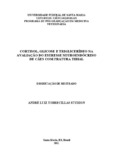| dc.creator | Sturion, André Luiz Torrecillas | |
| dc.date.accessioned | 2017-05-29 | |
| dc.date.available | 2017-05-29 | |
| dc.date.issued | 2011-09-30 | |
| dc.identifier.citation | STURION, André Luiz Torrecillas. Cortisol, glucose, and tryglicerides in neuroendocrine response of dogs whit tibial fracture. 2011. 37 f. Dissertação (Mestrado em Medicina Veterinária) - Universidade Federal de Santa Maria, Santa Maria, 2011. | por |
| dc.identifier.uri | http://repositorio.ufsm.br/handle/1/10105 | |
| dc.description.abstract | "Response to stress" is the designation for the set of metabolic and hormonal
changes that take place after any traumatic situation. The stress response is intended to
maintain and / or restore the homeostasis of the body injured. The major endocrine
response to stress is characterized as the increased secretion of pituitary hormones and
activation of the sympathetic nervous system. Among the pituitary hormones is ACTH,
which will sensitize the cells of the adrenal gland to secrete cortisol. The biochemical
measurements, especially cortisol and glucose has been shown to be important
references for the evaluation of pain and stress by indirect means. Therefore, the
objective of this research is to measure cortisol, the glucose and triglyceride metabolic
energy, in evaluating the neuroendocrine response of dogs with tibial fractures. For the
present study, we used 12 dogs with tibial fractures. Were colected five venous blood
samples, at the time of patient care, during the surgical procedure after induction of
anesthesia, five minutes after stimulation by periosteal implant, 24 hours after the first
collection during surgery and after seven days of the surgery. There were no statistically
significant differences between times and between the values of cortisol, glucose and
triglycerides, but there was a numerical difference between the mean times analyzed, we
observed that the cortisol showed an average decrease between times. The mean glucose
values had increased in the pre and trans-surgical times, and with a decrease in mean
postoperative periods. Mean triglyceride values varied widely between periods. It is
possible to conclude that cortisol is an important mediator in the neuroendocrine
response of dogs with acute tibial fractures, the mean values of glucose did not respond
similarly to cortisol during surgical procedures and that the triglyceride is not a good
parameter for evaluating the neuroendocrine stress dogs with acute tibial fractures. | eng |
| dc.description.sponsorship | Conselho Nacional de Desenvolvimento Científico e Tecnológico | |
| dc.format | application/pdf | por |
| dc.language | por | por |
| dc.publisher | Universidade Federal de Santa Maria | por |
| dc.rights | Acesso Aberto | por |
| dc.subject | Osteossintese tibial | por |
| dc.subject | Eixo pituitário-adrenal | por |
| dc.subject | Cão | por |
| dc.subject | Tibial osteosynthesis | eng |
| dc.subject | Pituitary-adrenal axis | eng |
| dc.subject | Dog | eng |
| dc.title | Cortisol, glicose e triglicerídeo na resposta neuroendócrina de cães com fratura tibial | por |
| dc.title.alternative | Cortisol, glucose, and tryglicerides in neuroendocrine response of dogs whit tibial fracture | eng |
| dc.type | Dissertação | por |
| dc.description.resumo | Resposta ao estresse é a designação para o conjunto de alterações hormonais e
metabólicas que decorrem após qualquer situação de trauma. A resposta ao estresse tem
como finalidade manter e/ou restaurar a homeostase do organismo lesado. A principal
resposta endócrina ao estresse é caracterizada como o aumento da secreção de
hormônios pituitário e ativação do sistema nervoso simpático. Dentre os hormônios
pituitários está o ACTH, que irá sensibilizar as células da adrenal para secretar cortisol.
As mensurações bioquímicas, especialmente o cortisol e a glicose tem se mostrado
importantes referencias para a avaliação da dor e do estresse por meio indireto. Sendo
assim, o objetivo desta pesquisa é medir o cortisol, os metabólicos energéticos glicose e
triglicerídeo, na avaliação da resposta neuroendócrina de cães com fratura tibial. Para o
presente estudo, foram utilizados 12 cães com fratura tibial. Foram realizadas cinco
coletas de sangue venoso, no momento do atendimento do paciente, durante o
procedimento cirúrgico logo após a indução anestésica, cinco minutos após a
estimulação periosteal pelo implante, 24 horas após a primeira coleta durante o
procedimento cirúrgico e após sete dias do procedimento cirúrgico. Não foram
observadas diferenças estatísticas significativas entre os tempos e entre os valores de
cortisol, glicose e triglicerídeo, porém houve diferença numérica entre as médias dos
tempos analisados, sendo observado que o cortisol apresentou uma média decrescente
entre os tempos. As médias dos valores de glicose apresentaram acréscimo nos períodos
pré e trans cirúrgicos com decréscimo das médias nos períodos pós-cirúrgicos. As
médias dos valores de triglicerídeo apresentaram grande variação entre os períodos. É
possível concluir que o cortisol é um importante mediador na resposta neuroendócrina
aguda de cães com fratura tibial, os valores médios de glicose não responderam de
forma similar ao cortisol durante os procedimentos cirúrgicos e que o triglicerídeo não é
um bom parâmetro de avaliação do estresse neuroendócrino agudo de cães com fratura
tibial. | por |
| dc.contributor.advisor1 | Schossler, Joao Eduardo Wallau | |
| dc.contributor.advisor1Lattes | http://buscatextual.cnpq.br/buscatextual/visualizacv.do?id=K4784154D8 | por |
| dc.contributor.referee1 | Amaral, Anne Santos do | |
| dc.contributor.referee1Lattes | http://buscatextual.cnpq.br/buscatextual/visualizacv.do?id=K4728321T9 | por |
| dc.contributor.referee2 | Aguiar, Eduardo Santiago Ventura de | |
| dc.contributor.referee2Lattes | http://buscatextual.cnpq.br/buscatextual/visualizacv.do?id=K4761469D6 | por |
| dc.creator.Lattes | http://buscatextual.cnpq.br/buscatextual/visualizacv.do?id=K4232660A2 | por |
| dc.publisher.country | BR | por |
| dc.publisher.department | Medicina Veterinária | por |
| dc.publisher.initials | UFSM | por |
| dc.publisher.program | Programa de Pós-Graduação em Medicina Veterinária | por |
| dc.subject.cnpq | CNPQ::CIENCIAS AGRARIAS::MEDICINA VETERINARIA | por |


